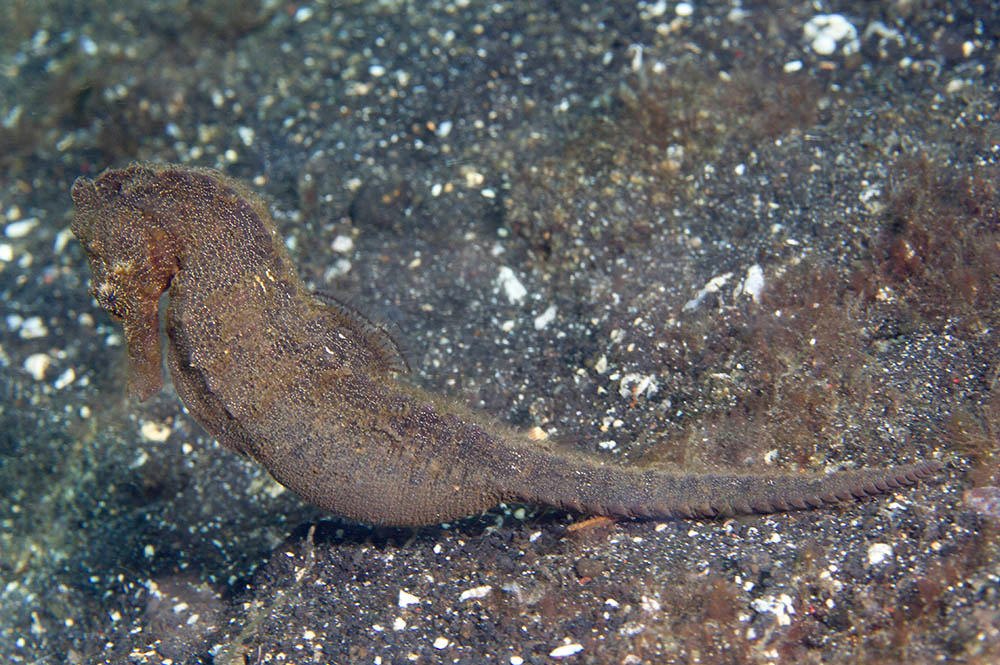- Classification
- ACTINOPTERYGII
- SYNGNATHIFORMES
- SYNGNATHIDAE
- Hippocampus
- taeniopterus
Common Seahorse, Hippocampus taeniopterus Bleeker 1852

A male Common Seahorse, Hippocampus taeniopterus, in Lembeh Straits, Sulawesi, Indonesia. Source: Paddy Ryan / www.ryanphotographic.com. License: All rights reserved
A dusky brown, grey or blackish seahorse, often with fine dark spots, pale scribbles and striations. Females may be yellowish with dark spots. The top of the head is relatively smooth and the coronet has a 'swept back' appearance. Adults often live in pairs in seagrass beds or amongst mangroves.
Common Seahorse, Hippocampus taeniopterus Bleeker 1852
More Info
|
Distribution |
Known from the Darwin area to southern Queensland. Elsewhere, the species occurs in the tropical Indo-west Pacific, from Indonesia (Moluccan Seas, Sulawesi and Bali) and Papua New Guinea. The Common Seahorse inhabits shallow estuaries, harbours and bays, often sheltering along the edges of seagrass beds or amongst mangroves in depths to about 15 m. During the wet season, juveniles and adults may be carried well-offshore on floating weeds. |
|
Features |
Dorsal fin 17-18; Pectoral fin 16-18 (rarely 17 or 18); trunk rings 11; tail rings 34-35; subdorsal rings 2 + 1-2. |
|
Size |
Height to 22 cm. |
|
Colour |
In life, overall grey to brown, often with fine dark spots, pale scribbles and striations; females sometimes yellow with pupil-sized black spots that may elongate on trunk over rings. In preservative - pale to dark brown, usually with small dark spots. |
|
Feeding |
Carnivores. Like most other seahorses, this species presumably feeds by sucking small prey items such as crustaceans and planktonic zooplankton in through the long snout. |
|
Biology |
Sexes separate, males brood the developing embryos and give birth to tiny independent young. The female uses an ovipositor to transfer her eggs into an elaborate enclosed pouch under the abdomen of the male. The male provides physical protection for the developing embryos, he also osmoregulates and aerates the embryos and may provide some nourishment until the offspring are born. |
|
Fisheries |
There is no known trade in this species for the aquarium or Asian Traditional Medicine industries. |
|
Conservation |
Listed under Appendix II of the Convention on the International Trade in Endangered Species of Wild Flora and Fauna (CITES). As a result, the species is subject to the Convention, http://www.cites.org/. |
|
Remarks |
H. taeniopterus is not as common in Australian waters as it is throughout other parts of its range. Adults regularly occur in floating weeds. |
|
Similar Species |
H. taeniopterus is most similar, and often confused with H. kuda, a species not found in Australian waters. H. kuda differs in having slight meristic and morphological differences, as well as usually having dermal appendages on the head spines, coronet, and on the enlarged spines or tubercles of superior ridges. |
|
Etymology |
From the Greek ippos = horse and kampe = curvature. The specific name taeniopterus is from the Latin taenia meaning ribbon, fillet and pterus meaning wing. |
|
Species Citation |
Hippocampus taeniopterus Bleeker 1852, Nat. Tijdschr. Ned. Ind. 3: 306. Type locality: Ambon I., Molucca Is., Indonesia. |
|
Author |
Dianne J. Bray & Vanessa J. Thompson |
Common Seahorse, Hippocampus taeniopterus Bleeker 1852
References
Allen, G.R. 1997. Marine Fishes of Tropical Australia and South-east Asia. Western Australian Museum.
Allen, G.R. & Erdmann, M.V. 2012. Reef fishes of the East Indies. Perth : Tropical Reef Research 3 vols, 1260 pp.
Bleeker, P. 1852. Bijdrage tot de kennis der ichthyologische fauna van de Moluksche Eilanden. Visschen van Amboina en Ceram. Natuurkd. Tijdschr. Neder. Indië 3: 229-309.
Kuiter, R.H. 2000. Seahorses, Pipefishes and their Relatives. TMC Publishing, Chorleywood, UK, 240 pp.
Kuiter, R.H. 2001. Revision of the Australian Seahorse of the genus Hippocampus (Syngnathiformes: Syngnathidae) with descriptions of nine new species. Rec. Aust. Mus. 53: 293-340.
Kuiter, R.H. 2009. Seahorses and their relatives. Seaford, Australia : Aquatic Photographics 331 pp.
Larson, H.K., Williams, R.S. & Hammer, M.P. 2013. An annotated checklist of the fishes of the Northern Territory, Australia. Zootaxa 3696(1): 1-293.
Lourie S.A., A.C.J. Vincent & H.J. Hall. 1999. Seahorses: an identification guide to the world's species and their conservation. Project Seahorse, London, UK. 214 pp.
Pogonoski, J.J., D.A. Pollard & J.R. Paxton. 2002. Conservation Overview and Action Plan for Australian Threatened and Potentially Threatened Marine and Estuarine Fishes. Canberra, Environment Australia, 375 pp.
Randall, J.E., G.R. Allen & R.C. Steene. 1997. Fishes of the Great Barrier Reef and Coral Sea, 2nd Ed. Crawford House Press, Bathurst.








